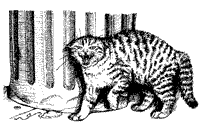|
Feral House Cats | Feral House Cat Overview | Feral Cat Damage Assessment | Feral Cat Damage Management | Feral Cat Resources | Feral Cat Acknowledgments | ICWDM | Wildlife Species Information |
Damage Prevention and Control Methods
Exclusion

Exclusion by fencing, repairing windows, doors, and plugging holes in buildings is often a practical way of eliminating cat predation and nuisance. Provide overhead fencing to keep cats out of bird or poultry pens. Wire mesh with openings smaller than 2.5 inches (6.4 cm) should offer adequate protection.
Cultural Methods
Cat numbers can be reduced by eliminating their habitat. Old buildings should be sealed and holes under foundations plugged. Remove brush and piles of debris, bale piles, old machinery, and junked cars. Mow vegetation in the vicinity of buildings. Elimination of small rodents and other foodstuffs will reduce feral cat numbers.
Frightening
Dogs that show aggression to cats provide an effective deterrent when placed in fenced yards and buildings where cats are not welcome.
Repellents
The Environmental Protection Agency (EPA) has registered Ropel for deterring cats. There is little objective evidence, however, of its effectiveness. The repellent carries a warning about fabric damage and possible phytotoxicity. When used outdoors, repellents must be reapplied frequently. Outdoor repellents can be used around flower boxes, furniture, bushes, trees, and other areas where cats are not welcomed. Repellents are often irritating and repulsive to humans as well as cats.
Toxicants
No toxicants are registered for control of feral cats.
Fumigants
No fumigants are registered for control of feral house cats.
Trapping
NOTE: In many states cats are NOT considered wildlife, and may fall under the jurisidiction of the State Agriculture Department or other agencies. Check all state and local regulations before trapping feral cats. This activity may not be covered under a state nuisance wildlife control license.
Box Traps
Figure 2a. Front and partial interior of box trap set. Figure 2b. Side view of cat trap.


Box Trap:
1 – Door up in grooves guiding its fall.
2 – Treadle board resting on a fulcrum. (Fulcrum made by nailing a small piece of wood across floor of trap. Weight of animal on back part of treadle depresses treadle, pulls back trigger wire and allows door to fall.)
3 – Trigger wire. (Three-gauge wire is connected to a screw eye at one side of treadle and back of fulcrum, extended along side of box to top of trap and passed through a second screw eye. When trap is set, door rests on the projecting end of trigger wire.)
4 – Back wall with 3-inch square opening. (Inside of opening is screened and provided with a tight door on outside to permit observation of captive animal.)
5 – Uprights containing grooves in which door slides. (Grooves should be greased for easy action of door.)
Box-trapping cats in commercial or homemade box traps (Fig. 2) is a feasible control alternative, particularly in areas where uncontrolled pets are more of a problem than wild cats. Trap openings should be 11 to 12 inches (28 to 30 cm) square and 30 inches (75 cm) or more long. Double-ended traps should be at least 42 inches (105 cm) long. The cat can be captured and turned over to animal control agencies without harm, or given back to the owner with proper warnings. Sources for commercial traps are found in WDM Supplies And Materials. Set box traps in areas of feral cat activity, such as feeding and loafing areas, travel ways along fences, tree lines, or creeks, dumps, and garbage cans. Successful baits include fresh or canned fish, commercial cat foods, fresh liver, and chicken or rodent carcasses. Catnip and rhodium oil are often effective in attracting cats.
Other Methods
Supplemental feeding of feral or free-roaming house cats will probably have little effect in reducing their depredations on songbirds and other wildlife. Even well-fed cats will often bring home small prey they have caught and proudly display it to their owners without eating it. Laboratory studies suggest that hunger and hunting are controlled by separate neurological centers in the cat brain, so the rate of predation is not affected by the availability of cat food.
The hunter is often the hunted. Dogs and coyotes, which are adapting to urban environments, are probably the greatest predators of cats, next to humans and cars. Feral cats are often found on the borders of human habitation. Large predators such as bobcats, mountain lions, fox, coyotes, and feral dogs eliminate cats that stray too far afield.
In the final analysis, many problems with feral cats could be avoided if cat owners would practice responsible pet ownership. The same licensing and leash laws pertaining to dogs should be applied to cats. Spaying or neutering should be encouraged for household pets not kept for breeding purposes. Neutering is not a cost-effective program for controlling feral populations. Unwanted cats should be humanely destroyed, not abandoned to fend for themselves.
Summary of Damage Prevention and Control Methods
Exclusion
Practical for protecting small poultry and mammals.
Cultural Methods
Clean up debris, burn refuse and brush piles, seal buildings, reduce habitat and food sources.
Repellents
Many products are registered but are practical only for small areas.
Frightening
Dogs.
Toxicants
None are registered.
Fumigants
None are registered.
Trapping
Box traps. No. 1, 1.5, or 2 leg hold traps. No. 220 Conibear® or body-gripping
traps. Snares.
Shooting
Center fire rifles, .22 rim fire rifles, and shotguns are effective for quick removal.
Other Methods
Responsible care by cat owners
|
Feral House Cats | Feral House Cat Overview | Feral Cat Damage Assessment | Feral Cat Damage Management | Feral Cat Resources | Feral Cat Acknowledgments | ICWDM | Wildlife Species Information |
